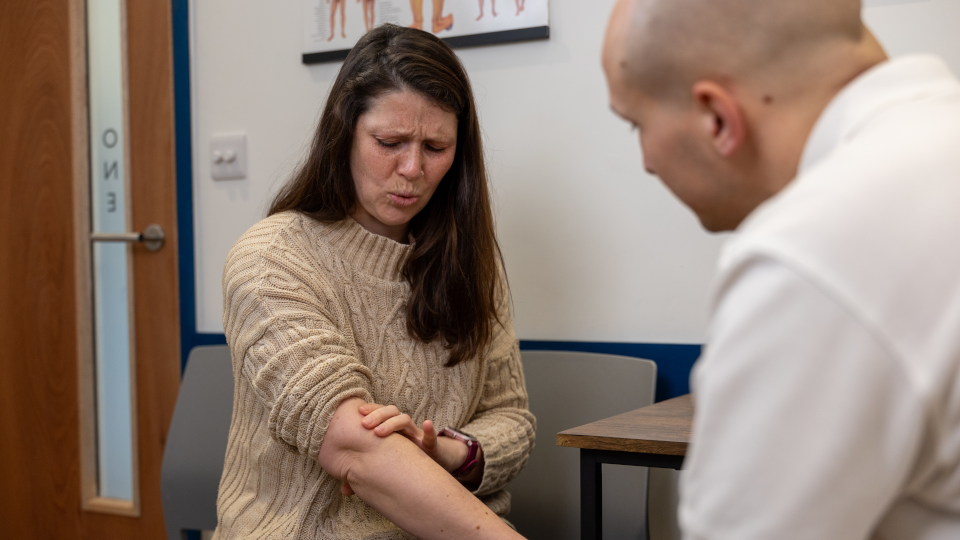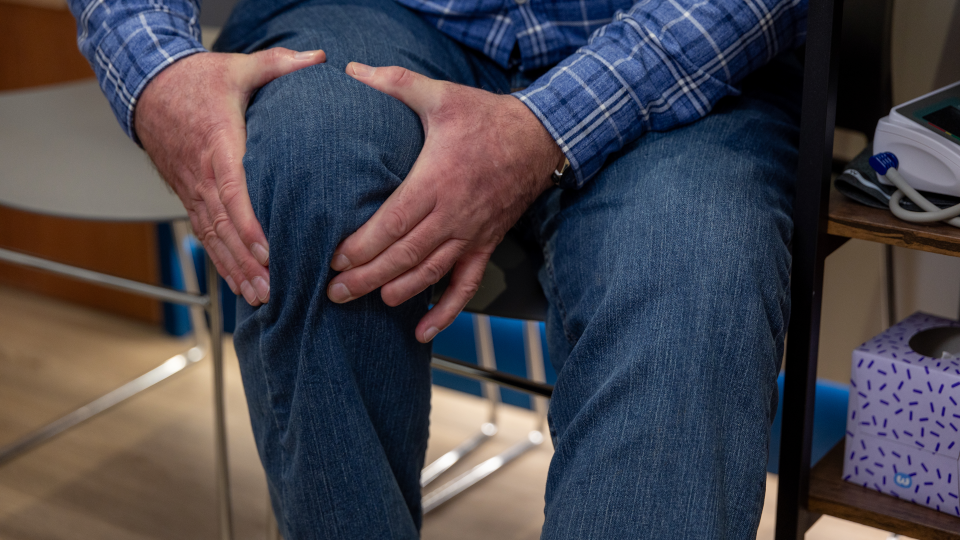“My Pain Is So Acute, It’s Chronic”: The Surprising Truth About Different Types Of Pain
You may have heard someone you love describe their pain as “really acute” or “absolutely chronic”, both of which sound really bad. But what do they mean? In this article we’ll look at what these terms mean medically and the differences between them. (9 minute read)
The exact meaning of “acute” and “chronic” when it’s used by patients can vary, because everyone’s knowledge and experience of pain is individual. That being said, in our experience:
“Really acute pain” is generally understood by non-medical folk to mean something that is very sensitive or tender to touch (sometimes you will hear medical professionals describe something as “acutely painful” - this is a more accurate way of describing this kind of pain experience.)
When pain is described as “absolutely chronic”, our patients are generally talking about quite deep pain that is hard to put their finger on, and often constant.
However these terms, when used by Doctors, Surgeons, Physiotherapists and other health professionals, say nothing about the nature of pain. They do not describe pain that is sharp, stabbing, deep, intense, burning or any other physical sensation. So what do they describe?
The main difference is time. But this difference is used to help assess something a bit more important clinically. Let’s dive into the detail.
What Is Acute Pain?
“Acute Pain” is not the same as “Acutely Painful”
The short version: Acute Pain is pain that has gone on for three months or less.
Acute pain comes on very quickly, and usually in response to an obvious injury. Often it will be accompanied by swelling, heat, or bruising around the affected area. The pain acts as a sort of protective mechanism, prompting us to go easy on the injury so that the body can heal. Acute pain will ease and eventually resolve as the injury heals - usually days or weeks in minor injuries, but up to three months for some more serious injuries.
If this all sounds very normal and almost a bit obvious, you would be right (…or maybe just lucky that your pain experiences have all been like this - but more about that in a minute!)
Acute Pain can be thought of as the normal functioning of the pain apparatus while an injured area heals. By contrast, Chronic Pain is used clinically to describe a situation where the normal functioning of that apparatus has been hijacked somehow. But how does that happen?
What Is Chronic Pain?
Using our time-based criteria, Chronic Pain is usually defined as pain that goes on for a long period of time. Six months is the usual benchmark to be reached before pain is considered clinically Chronic. What is special about six months though?
Most injuries will heal after three months or so with very few exceptions. Chronic Pain is defined as pain that persists beyond the expected time for tissue healing. Unlike acute pain, Chronic Pain serves no protective purpose and can significantly impact an individual's quality of life. It can be triggered by an initial injury, or in some cases have no obvious starting point. Emotional factors like stress, anxiety or depression can also worsen the development of Chronic Pain.
Chronic Pain has often gone on for years with little improvement
Chronic Pain sufferers can struggle with finding support as their condition can be complex. In the past, many were thought to be “malingerers”, or people with “low pain thresholds”. We now know that persistent pain can cause physical changes in the nervous system, including:
Nerve endings - making more of them and existing nerve endings more sensitive
Spinal cord - making “pain gates” more sensitive
Brain - causing growth of new connections which enhance the sensitivity of affected areas of the body
As you can imagine, these changes can cause a pain sufferers’ experience to worsen considerably, especially when they are combined. So the increased sensitivity in Chronic Pain sufferers is definitely not “all in their head”. It is important to remember though that these changes are reversible.
Some factors that increase the likelihood and severity of Chronic Pain include (but are not limited to):
Intensity of Pain
Longer time suffering with pain
Impact on work or social life
Involvement in litigation (e.g. Road Traffic Accident claim) related to the injury
Behavioural changes
Unhelpful beliefs around pain and disability
Presence of other chronic illnesses like diabetes, poor health in general
Socioeconomic factors - low income, low education, low access to healthcare
As you might imagine, recovery from Chronic Pain is often a complex process. Since Chronic Pain is a long-term condition, the primary goal of treatment is to manage and improve the quality of life rather than aiming for complete elimination of pain. A multidisciplinary approach is often employed, involving physiotherapy, medication, psychological support, and lifestyle modifications.
So, returning to our more nuanced meaning, we can see that Acute Pain is a straightforward, normal and expected process relating to injury, whereas Chronic Pain is messy and has little relationship with the physical recovery of the tissues.
Chronic Pain can often “spread” to nearby areas over time
Many people have niggles that go on for months or even years. You may even have one yourself! So is every instance of pain lasting longer than six months, “Chronic Pain”? If you leave pain unaddressed, are you surely doomed to a lifetime of misery?
Chronic Pain Or Just Long Standing Pain?
It’s not always clear when pain that has gone on longer than the expected healing time becomes the complex twisted web that is textbook “Chronic Pain”. We see plenty of patients for whom an ongoing niggle turns out to be just that, and some simple changes can still produce quick results. In our experience, these patients tend to have fewer social and lifestyle changes associated with their pain though. Often they will have continued working and socialising, living well with their pain rather than building a lifestyle around it.
We don’t know exactly what’s happening here - maybe they were in a Chronic Pain state, but with changes to their nervous system and behaviour that were easily reversed. Maybe they weren’t in a Chronic Pain state, but rather recurring Acute Pain episodes over the years. Or maybe they are lucky to have very responsive and adaptable nervous systems!
Exercise is one of the best ways to deal with pain, whether Acute or Chronic
The types of physical changes to the nerves described above don’t happen in every case of longstanding pain, and it’s not clear why some patients get dragged into Chronic Pain states and others don’t. However physiotherapist and noted pain researcher Louis Gifford put together this tongue-in-cheek list in his masterpiece “Aches and Pains” book. In it, he says if you want pain to stay and become Chronic, next time you have a painful episode, follow these helpful tips, summarised here:
Make the pain the main thing in your life. Talk about your pain all the time to others. Join a similar-minded group of sufferers, so you can all talk about your pain all the time; they’ll help you through the week.Set up a Facebook page about your problem, and post about it frequently
Give it high value - think about it, concentrate on it, keep coming back to it and concentrate on it again and again (Try and get to know every little nuance of its character and behaviour over time and let it worry you about possible nasty things going on. Try and associate it with something that might maim, disable or even end your life. Rate it as 100% torture)
Stop working and functioning and try to lead a life of total boredom - so that you can spend lots of time listening to your body and the pain; don’t let distractions like work, hobbies, family and socialising get in the way of time well-spent on concentrating on the pain
Add emotion to it - try to feel fearful and anxious about it all the time and keep wondering what it is and what it means in terms of threat
Don’t listen to professionals who listen to you, who do some testing and who try to reassure you and then give you a simple natural history so you know what normally happens.
Instead, listen to therapists who tell you it is serious and use words like “degeneration”, “stuck”, “trapped”, “out”, “inflamed”, “bad”, “may need an operation”, “could be serious”, “the back of a 90 year old”. And who suggest that you “stop work and look for something sedentary”, “stop those active hobbies you enjoy” and “think about early retirement to focus on your recovery”.
Be sure to seek out information about pain disasters on the internet, and listen to your friends and neighbours who tell you stories about someone they knew with symptoms just like yours, who ended up dying of some nasty cancer that wasn’t diagnosed in time. (Yes, try and seek out information that will worry you about the pain and the cause of it. Feed the bogey man in your head saying: “this is serious, they’ve missed something.” Remember the saying: ‘A little knowledge is a helpful thing’.)
Refuse any form of medication or therapy that helps or gets rid of the pain
Make sure you feel hopeless and helpless and keep reminding yourself that no therapy is ever going to help
Use supports, sticks, mobility scooters, collars and corsets as much as possible to remind you of your problem and help your body become reliant, weak vulnerable and deconditioned; you know it’s best to be sedentary and the risk of over-doing it
Make sure your spouse/significant other is “solicitous” - in other words they’re nice to you all the time, constantly ask about the pain, don't let you do anything for yourself in case you make it worse and also go out of their way to make you feel helpless and hopeless
Make your pain your new hobby, make it fun and enjoy it, you know it makes sense
And so on. I hope you get the picture? Of course do the opposite if you don’t want pain to become imprinted!
These are bound to resonate with anyone who’s had long standing pain or knows someone who has suffered with Chronic Pain. You can get started with some actual useful tips with Pete Moore at PainToolkit.org. Of course, doing the recovering is a lot harder than reading about it. We liked this explanation of one patient’s Chronic Pain experience:
If you’ve got this far and you’d like to know more about the best way to deal with Chronic Pain, you can book an appointment with us or get in touch if you have further questions.




